外研版(2019)必修 第一册Unit 5 Into the wild Developing ideas精品课件(共16张PPT)
文档属性
| 名称 | 外研版(2019)必修 第一册Unit 5 Into the wild Developing ideas精品课件(共16张PPT) |  | |
| 格式 | pptx | ||
| 文件大小 | 3.0MB | ||
| 资源类型 | 教案 | ||
| 版本资源 | 外研版(2019) | ||
| 科目 | 英语 | ||
| 更新时间 | 2023-02-26 12:16:17 | ||
图片预览

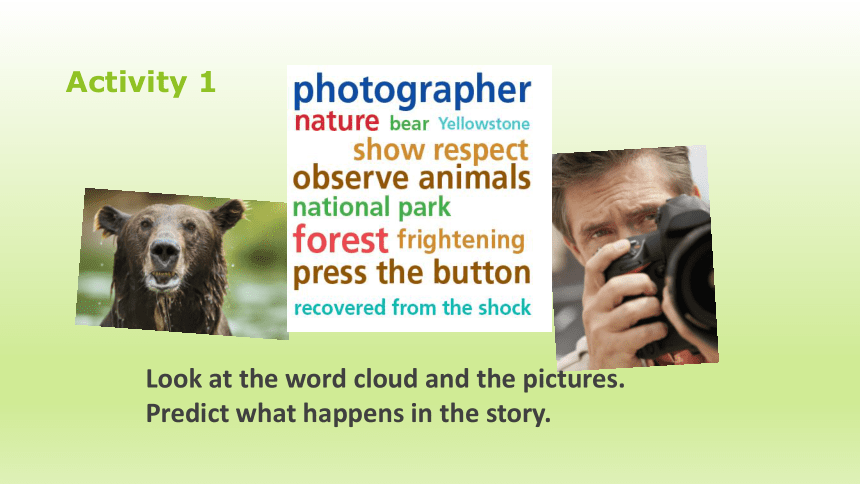

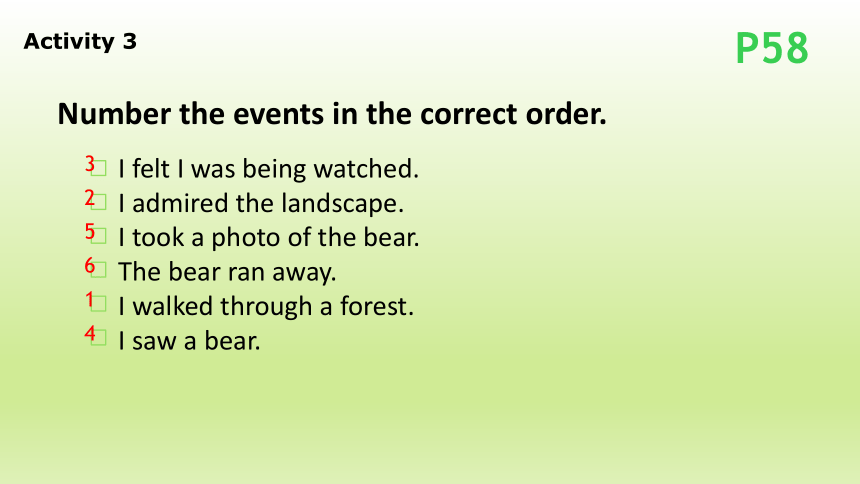
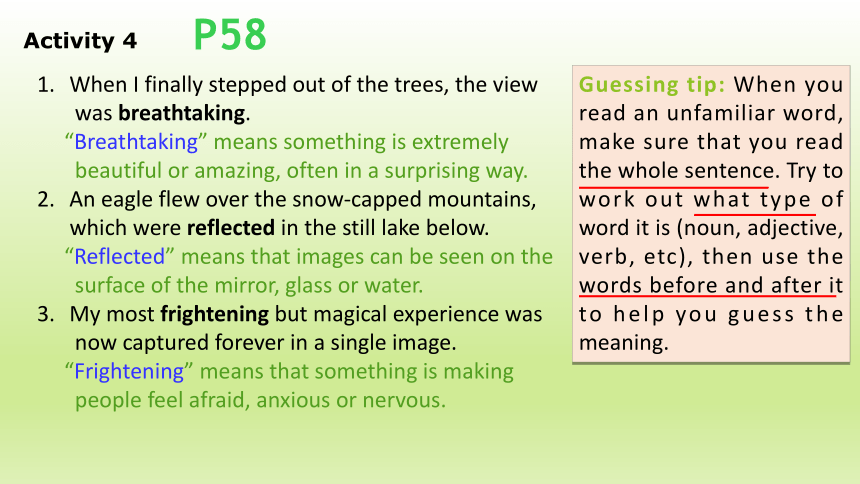
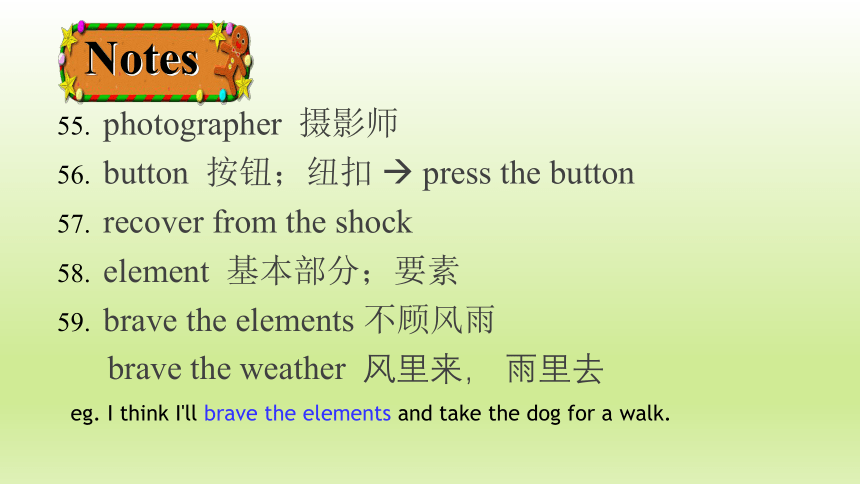
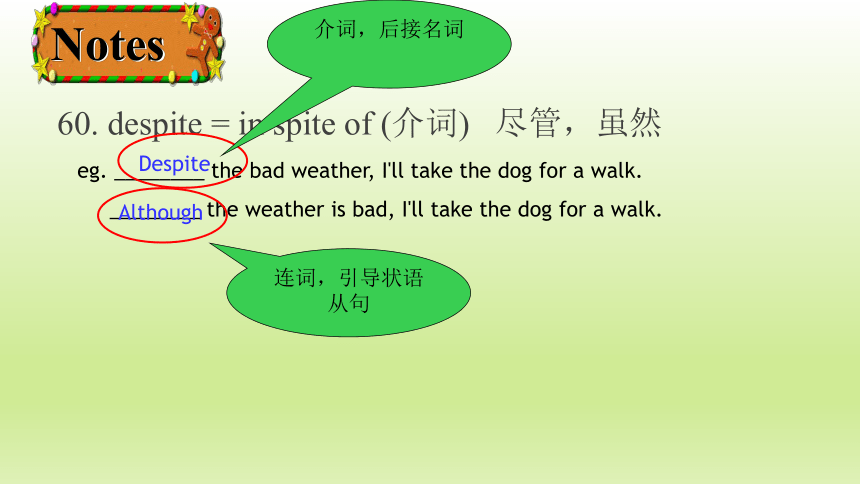
文档简介
(共16张PPT)
Unit 5 Into the wild
Developing ideas
新标准《英语》高中必修第一册
P56
Activity 1
Look at the word cloud and the pictures. Predict what happens in the story.
Activity 2
The story is about a photographer’s frightening and magical experience.
Read the passage and finish the following tasks.
1. Is your prediction right
2. What is the story about (the title and topic sentences)
Activity 3
Number the events in the correct order.
I felt I was being watched.
I admired the landscape.
I took a photo of the bear.
The bear ran away.
I walked through a forest.
I saw a bear.
P58
1
2
3
4
5
6
Activity 4
When I finally stepped out of the trees, the view
was breathtaking.
“Breathtaking” means something is extremely
beautiful or amazing, often in a surprising way.
An eagle flew over the snow-capped mountains,
which were reflected in the still lake below.
“Reflected” means that images can be seen on the
surface of the mirror, glass or water.
My most frightening but magical experience was
now captured forever in a single image.
“Frightening” means that something is making
people feel afraid, anxious or nervous.
Guessing tip: When you read an unfamiliar word, make sure that you read the whole sentence. Try to work out what type of word it is (noun, adjective, verb, etc), then use the words before and after it to help you guess the meaning.
P58
photographer 摄影师
button 按钮;纽扣 press the button
recover from the shock
element 基本部分;要素
brave the elements 不顾风雨
brave the weather 风里来, 雨里去
Notes
eg. I think I'll brave the elements and take the dog for a walk.
60. despite = in spite of (介词) 尽管,虽然
Notes
eg. ________ the bad weather, I'll take the dog for a walk.
________ the weather is bad, I'll take the dog for a walk.
Despite
Although
连词,引导状语从句
介词,后接名词
variety 多样化,变化 various vary
be famous for = be known for
at a speed of
per
path
breathtaking 令人惊叹的
eagle 鹰
concentrate (+on)专注于
Notes
freeze (froze, frozen)
使结冰,凝固;呆住,突然停止
70. stare (+at ) 凝视,盯着看
glare (+at ) 怒目而视
glance (+at ) 瞥一眼
71. Time stood still. 时间静止
72. force sb. to do
73. capture 记录;捕捉
Notes
74. image 图像;影像
75. from time to time = now and then = sometimes
76. show respect to
77. reminder
78. after all
79. It is after all we who are the visitors to their world.
80. encounter 邂逅,意外地遇见
Notes
强调句: It be +被强调部分 + that/who +其他
Eg. It was in the school that I met her.
Eg. It is Tom who broke the window.
Eg. It was because of his hard-working that he succeeded.
Writing an animal fact file
P59
Activity 6
1. What does the red-crowned crane look like
It has white feathers except for some black ones
on its face, neck and wings. It also has bright red
skin on the top of its head.
2. Where can you find it
It can be found in China, Russia, Mongolia, Japan
and the Korean Peninsula.
3. Where does it migrate to
It migrates to east-central China when the
weather gets cold.
4. What does it eat
It eats fish, snails and water plants.
5. What symbolic meaning does the red-crowned crane
have in Chinese culture
It has a symbolic meaning of long life and good luck
in Chinese culture.
P59
Activity 6
Useful Expressions
It is… tall.
It gets its name from…
Its unique feature is…
Its food includes…
It is a symbol of…
Activity 7
Animal the Siberian crane (the snow crane)
Appearance 140 cm in height
nearly all snowy white feathers, except for some black ones
red featherless face
Habitat East Asia
Migration China or Iran
Diet fish, insects, the roots and tubers of water plants, etc.
Other information a symbol of elegance, purity, good fortune and long life
Activity 8
参考范文:
The Siberian crane is also known as the snow crane. It is about 140 cm in height, generally shorter than the red-crowned crane. Its feathers are nearly all snowy white except for some black ones that are only visible in flight. Its featherless face is reddish(淡红色) in colour. The Siberian crane is usually found in East Asia, where its numbers are known as the eastern populations. These migrate to China in winter. Other much smaller populations migrate to Iran in winter. The snow crane has a good and diverse appetite, including fish, insects, the roots and tubers of water plants and so on. In Chinese culture, the snow crane is a symbol of elegance(高雅), purity(纯洁), good fortune and long life.
Unit 5 Into the wild
Developing ideas
新标准《英语》高中必修第一册
P56
Activity 1
Look at the word cloud and the pictures. Predict what happens in the story.
Activity 2
The story is about a photographer’s frightening and magical experience.
Read the passage and finish the following tasks.
1. Is your prediction right
2. What is the story about (the title and topic sentences)
Activity 3
Number the events in the correct order.
I felt I was being watched.
I admired the landscape.
I took a photo of the bear.
The bear ran away.
I walked through a forest.
I saw a bear.
P58
1
2
3
4
5
6
Activity 4
When I finally stepped out of the trees, the view
was breathtaking.
“Breathtaking” means something is extremely
beautiful or amazing, often in a surprising way.
An eagle flew over the snow-capped mountains,
which were reflected in the still lake below.
“Reflected” means that images can be seen on the
surface of the mirror, glass or water.
My most frightening but magical experience was
now captured forever in a single image.
“Frightening” means that something is making
people feel afraid, anxious or nervous.
Guessing tip: When you read an unfamiliar word, make sure that you read the whole sentence. Try to work out what type of word it is (noun, adjective, verb, etc), then use the words before and after it to help you guess the meaning.
P58
photographer 摄影师
button 按钮;纽扣 press the button
recover from the shock
element 基本部分;要素
brave the elements 不顾风雨
brave the weather 风里来, 雨里去
Notes
eg. I think I'll brave the elements and take the dog for a walk.
60. despite = in spite of (介词) 尽管,虽然
Notes
eg. ________ the bad weather, I'll take the dog for a walk.
________ the weather is bad, I'll take the dog for a walk.
Despite
Although
连词,引导状语从句
介词,后接名词
variety 多样化,变化 various vary
be famous for = be known for
at a speed of
per
path
breathtaking 令人惊叹的
eagle 鹰
concentrate (+on)专注于
Notes
freeze (froze, frozen)
使结冰,凝固;呆住,突然停止
70. stare (+at ) 凝视,盯着看
glare (+at ) 怒目而视
glance (+at ) 瞥一眼
71. Time stood still. 时间静止
72. force sb. to do
73. capture 记录;捕捉
Notes
74. image 图像;影像
75. from time to time = now and then = sometimes
76. show respect to
77. reminder
78. after all
79. It is after all we who are the visitors to their world.
80. encounter 邂逅,意外地遇见
Notes
强调句: It be +被强调部分 + that/who +其他
Eg. It was in the school that I met her.
Eg. It is Tom who broke the window.
Eg. It was because of his hard-working that he succeeded.
Writing an animal fact file
P59
Activity 6
1. What does the red-crowned crane look like
It has white feathers except for some black ones
on its face, neck and wings. It also has bright red
skin on the top of its head.
2. Where can you find it
It can be found in China, Russia, Mongolia, Japan
and the Korean Peninsula.
3. Where does it migrate to
It migrates to east-central China when the
weather gets cold.
4. What does it eat
It eats fish, snails and water plants.
5. What symbolic meaning does the red-crowned crane
have in Chinese culture
It has a symbolic meaning of long life and good luck
in Chinese culture.
P59
Activity 6
Useful Expressions
It is… tall.
It gets its name from…
Its unique feature is…
Its food includes…
It is a symbol of…
Activity 7
Animal the Siberian crane (the snow crane)
Appearance 140 cm in height
nearly all snowy white feathers, except for some black ones
red featherless face
Habitat East Asia
Migration China or Iran
Diet fish, insects, the roots and tubers of water plants, etc.
Other information a symbol of elegance, purity, good fortune and long life
Activity 8
参考范文:
The Siberian crane is also known as the snow crane. It is about 140 cm in height, generally shorter than the red-crowned crane. Its feathers are nearly all snowy white except for some black ones that are only visible in flight. Its featherless face is reddish(淡红色) in colour. The Siberian crane is usually found in East Asia, where its numbers are known as the eastern populations. These migrate to China in winter. Other much smaller populations migrate to Iran in winter. The snow crane has a good and diverse appetite, including fish, insects, the roots and tubers of water plants and so on. In Chinese culture, the snow crane is a symbol of elegance(高雅), purity(纯洁), good fortune and long life.
